10 Mistakes You're Making With Canned Herring
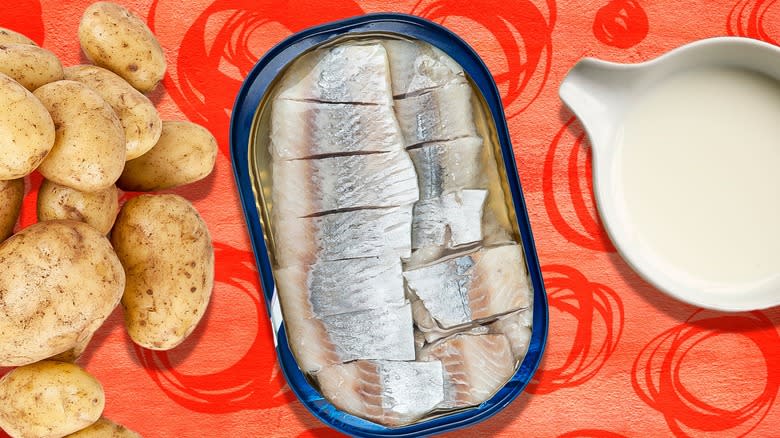
While Helen of Troy was the face that launched a thousand ships, herring may have launched more. Wars were fought over it centuries ago.
In fact, fresh herring has long been a staple in many coastal communities on the Atlantic, particularly in Northern Europe, where it has been smoked, salted, and pickled to preserve its rich, distinctive flavor so it could last through times of strife or be transported over large distances without spoiling. Incidentally, this is how we know and love it today. Before that, the fish was so important in European culinary tradition that it directly contributed to the founding of major cities like Amsterdam and Copenhagen, where residents have been consuming herring in copious amounts since the Middle Ages. And, Norwegians ate it every day to get through those lean times after WWII. Luckily, we have come a long way since then.
Nowadays, there are a lot of different ways to prepare and enjoy herring, most of which involve some pickled or smoked canned herring rather than the fresh variety. In Scandinavia, herring is a crucial component of smorgasbords, often appearing as marinated or pickled preparations that add tang to the spread. In Germany, pickled herring is enjoyed with traditional labskaus. With so many ways to enjoy herring, many people still make some common mistakes with this fish in the kitchen, especially the canned variety. Let's take a look at some of those canned herring mistakes so you can avoid them in the future.
Read more: Hacks That Will Make Boiling Your Eggs So Much Easier
Dampening Its Smokiness
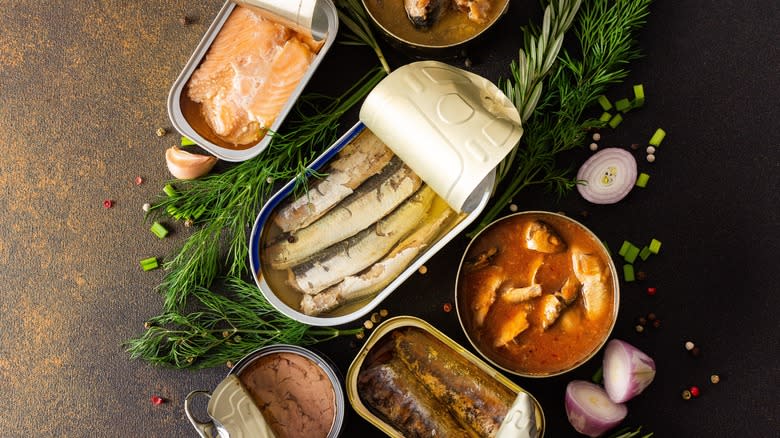
Smoked herring in a can is one of the simple pleasures in life. The fish, which is in abundant supply throughout the world, is relatively inexpensive but as tasty as can be, especially in smoked form. Its unique flavor profile is what makes it a great addition to a wide variety of recipes, especially since canned smoked herring comes pre-cooked and doesn't require any additional steps to add to a dish.
One such dish where canned herring comes in handy is fish tacos because you won't have to source fresh fish, cook it, and debone it. With smoked herring, all that has been taken care of. But you should also take care to preserve that signature smokiness as much as possible, as it will add an intriguing depth of flavor to your meal. You can do this in several different ways. For one, you can saute the smoked herring with some chipotle chilis or chipotles in adobo sauce. These will make the herring spicy, for sure, but also amplify its smokiness. For something that will have a similar effect without adding the spice factor, consider sauteing the herring with some onions and bell peppers, which will caramelize and complement the herring's smokiness. A dash of lime juice at the end will also provide a nice accent to this flavor.
Overcomplicating Canned Herring

Canned herring, with a bit of bread and a side of vegetables, can be a meal in itself. In other words, since it already comes cooked and full of flavor, you can eat herring straight out of the tin with impunity. Indeed, by the time you find it at the store, it has already been thoroughly cleaned, deboned, chopped, heated, and smoked or pickled before being immersed in brine.
If you're looking for a simple and easy food to give your meal some protein or just as a snack, canned herring is for you. In fact, it's best not to overcomplicate this food. While herring, in its various forms, can easily be added to many different dishes, enjoying it straight up can be its own reward. Grab your favorite crackers and plop a smoked herring on top for a mid-afternoon snack. Or get hold of some hearty artisanal rye bread and top it with that herring, allowing the juices to soak into the crumb. Either way, you'll end up with a satisfying, filling, and tasty bite.
Not Eating Enough Canned Herring
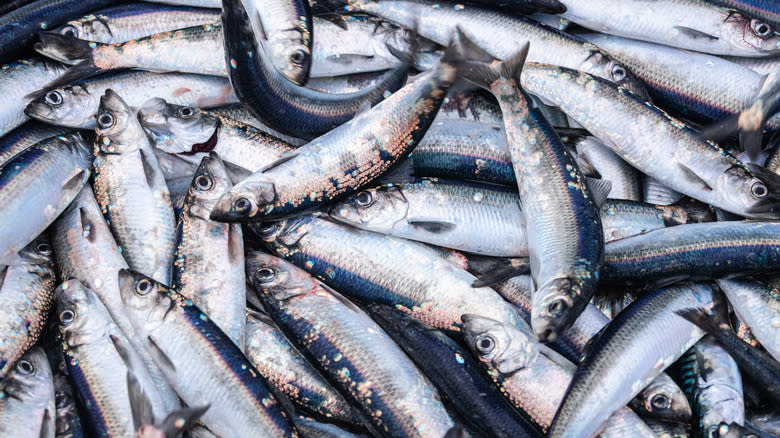
Herring in all its forms is a pleasure to eat when properly prepared, but it can also give you a major nutritional boost. The fish is chock-full of healthy fats and omega-3 fatty acids, which are the stuff you find in fish oil supplements and can supposedly help improve muscle functioning and fetal brain development and reduce the risk of heart disease. In addition, herring contains plenty of vitamin D, selenium, and iron, and a mere 3-ounce serving of herring will provide about 20 grams of protein. Just be sure to select smoked or fresh herring if you're concerned about sodium, which has high levels in pickled herring.
But herring isn't just healthy. It is also one of the more sustainable fish out there, as the schools tend to remain within easy reach of fishing trawlers -– making it unnecessary to use excessive amounts of fuel or fishing gear that may damage the seabed.
Selecting The Wrong Brand
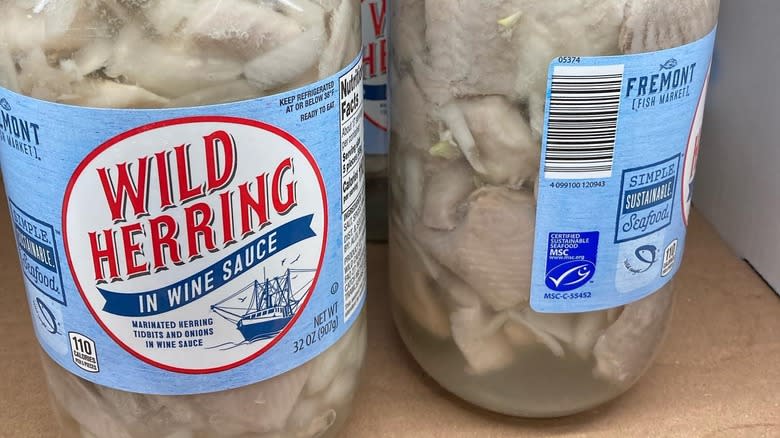
As with any food, herring can be of good or bad quality. The brand matters a lot when it comes to herring, and selecting the wrong one could lead to an unpleasant meal. Not to mention that it might unjustly ruin herring for you forever. Take this wild herring in wine sauce sold by Aldi, of which Reddit users have shown some deep apprehension. They noted, for instance, that the jar of herring was way too large and that it would take too long to finish. This may explain why one user said they would use this product "to put them on my hook and catch a fresh fish."
Other brands, on the other hand, are far better regarded than the equivalent of a worm at the end of a fishing pole. For instance, anything you can get from Russ & Daughters, a Jewish appetizing store with several outposts in New York City, is bound to be good. If you don't want to ruin your view of pickled herring forever, try the ones here for a sweet, oniony flavor that pairs well with pumpernickel bread.
Not Having Canned Herring With Potatoes

Canned herring goes well with many foods and can be consumed safely on its own. But there is one ingredient that seems to bring out the best in this fish, and that ingredient is potatoes, specifically in the form of a salad. This recipe, popular in northern European countries like Germany and Denmark, pairs the soft creaminess of potatoes with the tangy bite of pickled herring, all while providing a complete meal with starch, protein, and whatever vegetables you may want to add.
For instance, chopped pickled cornichons can amp up the brininess, along with some capers and a dash of sour cream dressing. Another beneficial ingredient to add, commonly found in these salads, is red onions, which provide some sweetness along with an added tang. Lastly, a sprinkle of dill -- an all-around favorite herb for fish –- and a dash of lemon juice will complete the flavor profile.
Being Unprepared For The Smell
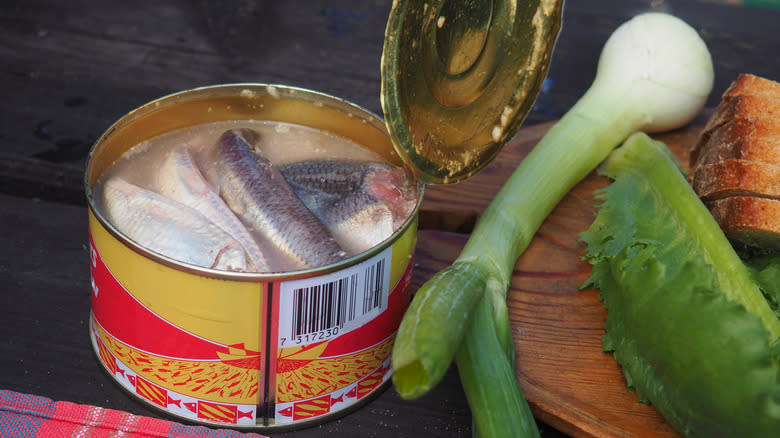
One thing about some types of herring is that it can be quite smelly, and if you're not prepared for that upon opening the tin, it might be off-putting. The odor may not be that pungent with smoked or pickled herring, but it's a whole other story with surstrӧmming, Sweden's notoriously stinky pickled herring made with fermented fish. And we're here to tell you that it's worth pushing past that initial discomfort.
At least, according to Ari Shapiro of NPR, who described the smell of this fermented herring "like Roquefort cheese, vinegar, and seafood all in one." But he learned the hard way that you shouldn't just dig into fermented herring straight from the can. Instead, it should be used as a topping for an open-faced sandwich along with butter, potatoes, red onions, and other complementary additions. In this context, the fermented herring becomes more of a background support for the other ingredients, intensifying their flavors with its salty tang.
Selecting Unsustainable Herring

Even though herring from certain areas can be more sustainable than other types of fish, there are shady fisheries out there getting up to no good anyway due to the equipment and skills needed to make a catch, which is why it's important to be mindful of the source of your herring. Indeed, herring stocks collapsed in the 1960s and 1970s due to overfishing, so many governments have instituted laws to promote the long-term sustainability of herring so this debacle doesn't happen again.
When you shop for your next can of herring, look out for signs of sustainable fishing. For instance, according to the Marine Conservation Society, which works to protect marine wildlife, it is best to choose herring that was fished in the North Sea and North Irish Sea, while steering clear of herring from the South Irish Sea or off the waters of the southwest of the U.K. Choosing sustainable options can help prevent overfishing and other climate-related degradation while ensuring the fish stocks remain healthy and plentiful.
Forgetting To Soak It In Milk

While it is not essential to soak herring in milk in order to enjoy it to its fullest, this little trick can be a huge help if you're trying to reduce the saltiness of the fish. Be sure to leave it in the liquid for at least 12 hours and no more than 24 hours. After removing the herring, it's important to drain and rinse it before patting it dry.
Once this is done, you'll have something akin to fresh fish to use in a variety of recipes. At this point, you could even pickle the herring yourself, if you fancy it. Just prepare a mixture of water, vinegar, sugar, allspice, caraway seeds, mustard seeds, and peppercorns, boil it, let it cool, and pour it over your de-salted herring along with any vegetables you might want to add. Let the fish pickle for up to two days, and you'll have your own, easy homemade pickled herring to add to potato salads, rye bread sandwiches, and more.
Pairing Canned Herring With The Wrong Bread

It's not like pairing herring with the wrong bread will result in disaster. Nothing untoward will happen if you put it on a baguette or a slice of sourdough bread. But you'd be missing out on the best possible flavor combination if you didn't consume your herring on a slice of rye. The slightly sour taste of the bread works well with herring in all its forms, especially tangy pickled herring.
But be sure to balance out those strong flavors with fresh and creamy ingredients. Spreading some butter on the rye before adding the herring will allow the fat to cut through the tangy herring, adding another flavor dimension, while red onions and dill will provide the hint of freshness that doesn't necessarily come naturally with a pickled or canned product. And if intense flavors are your thing, you won't mind substituting rye for pumpernickel, which is a type of rye but differs from its cousin in that it is sweeter and more sour. Basically, pumpernickel is a more extreme form of rye, which might be exactly what you need to handle the strong flavors of herring.
Adding It Too Early In The Recipe
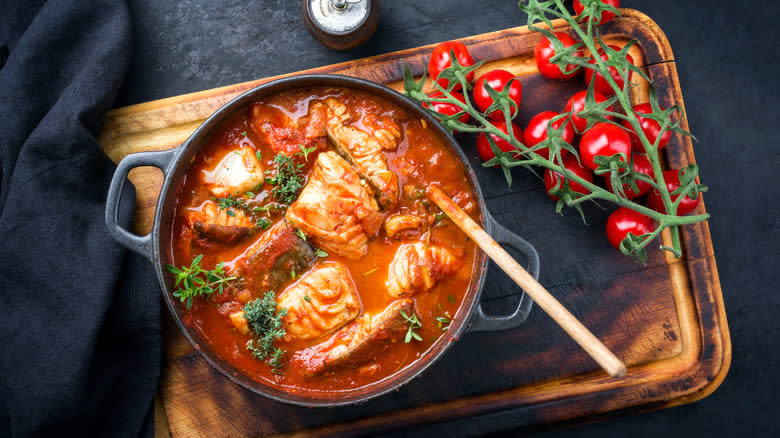
Canned herring is already heated and treated, meaning it is ready to eat straight from the tin. This also means that if you wanted to use herring in some other recipe, such as to flavor soup or sauces, you'd be dealing with a pre-cooked ingredient that doesn't need a lot of extra heat. Indeed, too much extra heat could cause the herring to disintegrate and even become a bit chewy. As such, it's important to add the herring to the recipe toward the end of cooking. That way, it will have enough time to heat up but not overcook.
For instance, if you were to use canned herring in a Mediterranean-style linguine, it would be best to add it at the very end and mix it in with the olive oil and cooked linguine. A similar idea stands with a variety of fish stews. It is not necessary to sear it or simmer it at length. Rather, treat it as you would prawns, which cook quickly, can get chewy when overcooked, and usually go in at the end of a recipe.
Read the original article on Tasting Table


